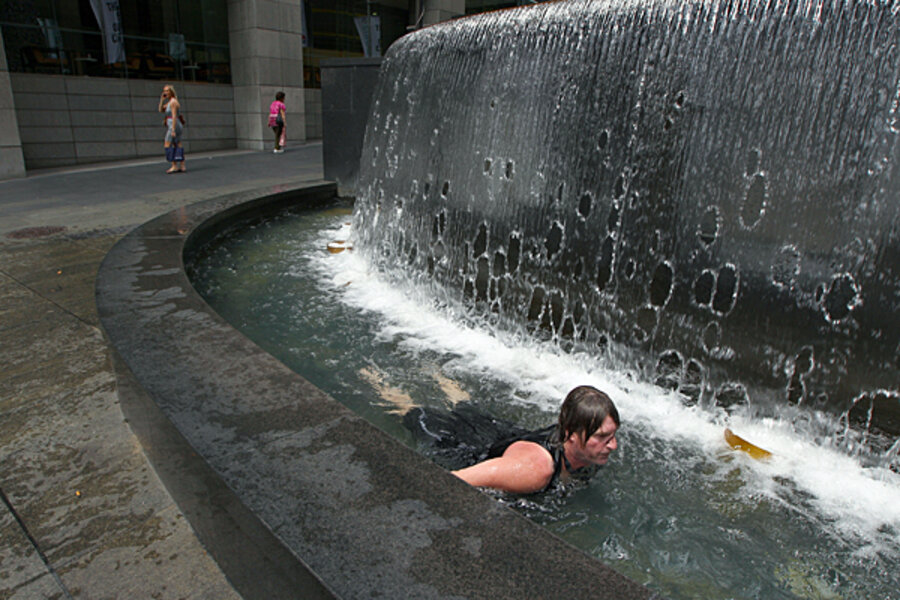Australia's milder temperatures aid firefighters
Loading...
| Cooma, Australia
Record temperatures across southern Australia cooled Wednesday, reducing the danger from scores of raging wildfires but likely bringing only a brief reprieve from the summer's extreme heat and fire risk.
Australia had its hottest day on record Monday with a nationwide average of 40.33 degrees Celsius (104.59 degrees Fahrenheit), narrowly breaking a 1972 record of 40.17 C (104.31 F). Tuesday was the third hottest day at 40.11 C (104.20 F). Four of Australia's hottest 10 days on record have been in 2013.
"There's little doubt that this is a very, very extreme heat wave event," said David Jones, manager of climate monitoring and prediction at the Bureau of Meteorology.
"If you look at its extent, its duration, its intensity, it is arguably the most significant in Australia's history," he added.
Cooler conditions brought relief to firefighters, who were battling around 200 fires across Australia's southeast, and gave them the chance to build earth breaks to try to contain the blazes. The risk from fire was expected to increase later in the week as temperatures again rise.
No deaths have been reported from the wildfires, although around 100 people haven't been accounted for since last week when a blaze destroyed around 90 homes in the Tasmanian town of Dunalley, east of the state capital of Hobart. On Wednesday, police spokeswoman Lisa Stingel said it was likely most of those people simply haven't checked in with officials.
Survivors have told stories of swirling flames, toxic fumes, and desperate escapes.
Tim Holmes fled his burning home near Dunalley on Friday with his wife Tammy and five grandchildren, aged 2 to 11, and took shelter in the sea beneath a wooden jetty.
"The difficulty was there was so much smoke and embers and there was probably 200 millimeters to 300 millimeters (8 to 12 inches) of air above the water," Holmes told Australian Broadcasting Corp. television on Monday.
"So we were all just heads; water up to our chins just trying to breathe because it was just — the atmosphere was so incredibly toxic," he added.
The fires have been most devastating in Tasmania, where at least 128 homes have been destroyed since Friday and more than 80,000 hectares (198,000 acres) burned. Hundreds of people remain at two evacuation centers in the state's south.
"People have lost everything. We can't comprehend that devastation unless we are in their shoes," Tasmanian Premier Lara Giddings said.
In Victoria state, north of Tasmania, a fire injured six people, destroyed nine homes and caused the evacuation of the farming community of Carngham west of the city of Ballarat, the Country Fire Authority said.
In New South Wales, Australia's most populous state, firefighters were battling 141 fires, including 31 that had not yet been contained. Fires burning out of control near the towns of Cooma, Yass and Shoalhaven were the most concerning.
Wildfires are common during the Australian summer. Fires in February 2009 killed 173 people and destroyed more than 2,000 homes in Victoria.
Jones, the meteorologist, said the current heat wave was a progression from the last four months of 2012, which were the hottest September-December period on record.
With Wednesday's cool-down in southern Australia, the national capital, Canberra, dropped from a high of 36 C (97 F) on Tuesday to 28 C (82 F) and Sydney dropped from 43 C (109 F) to 23 C (73 F).
Jones expected that Wednesday would also rank among Australia's hottest days when the national temperatures are calculated. That's because the extreme heat has shifted from the heavier populated south to northern and central Australia.
The bureau forecast above average temperatures for the remainder of the summer, compounding the fire danger created by a lack of rain across central and southern Australia over the past six months.
"It is going to be very challenging," Jones said of the wildfire danger.
The US government announced on Tuesday that 2012 had been the United States' hottest year on record.
A brutal combination of a widespread drought linked to a La Niña weather event and a mostly absent winter pushed the average annual US temperature last year up 0.6 C (1.08 F) above the previous record set in 1998 to 12.96 C (55.32 F).
The same La Niña brought flooding rains to much of Australia in the cool first half of 2012. The second half was dry and hot, ending the year with a daily temperature 0.11 C (0.2 F) above the daily average of 21.81 C (71.26 F).
___
Associated Press writer Kristen Gelineau in Sydney contributed to this report.







